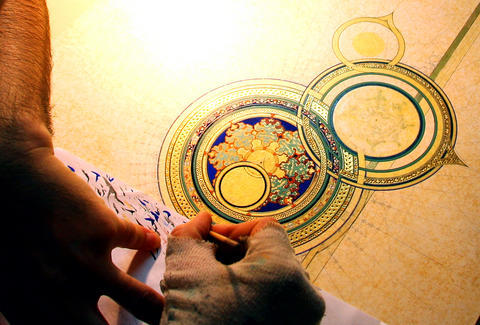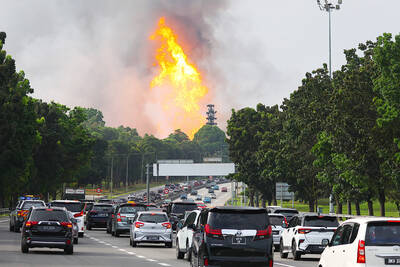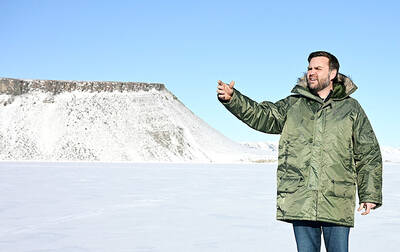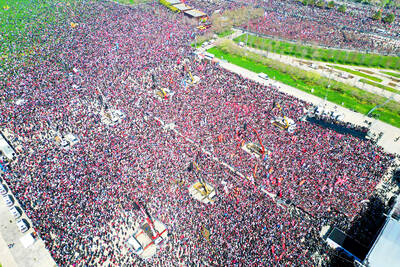Bent over his desk, an Iranian illuminator puts the last touches on a gilded garden of the minuscule intertwined paisleys that have decorated the Koran for hundreds of years.
One of the oldest Iranian art forms, illumination (tazhib) has survived since the pre-Islamic era but now risks extinction if it fails to attract patrons, who prefer modern art to traditional work.
Tazhib is non-figurative illumination whose geometric flourishes, decorations and intricate calligraphy have traditionally adorned the margins of holy books and epic poems, as well as being an art form in its own right.

PHOTO: AFP
"The perfection and harmony of this art speaks for itself," said illuminator Fereidoon Joghan, who has spent the past quarter of a century mastering this most rarefied of arts.
"I would like to create something beautiful rather than screaming a message," said the artist, who has won numerous national awards in Islamic decorative arts.
Joghan tries to work using traditional methods, including brushes made from cat's fur, and remaining as faithful as possible to the motifs and techniques created by masters hundreds of years ago.
Ridiculed by peers in Tehran's prestigious school of fine arts for his passion, Joghan said he had to abandon illumination temporarily at college, where he experimented with modern painting.
"The harmony and the intense concentration calm me to an extent that I forget all my problems," he said.
The art dates back to the Sassanid era in pre-Islamic Iran but flourished after the 7th century advent of Islam, which banned human depictions.
Faced with such limitations, Iranian artists poured their creative talent into beautifying the holy script, carpets and mosques.
"After Islam, the Koran was the only outlet of artistic work and it was the sanctity and importance of the book that has kept illumination alive through the ups and down of history," fellow tazhib artist Mehdi Moghiseh said.
The best works of illumination were created in the 15th century under the Timurid dynasty, when Iran's rulers of Mongol origin were great patrons of Persian art and literature.
This heyday of tazhib was sponsored by rulers who commissioned artists to enhance calligraphy in Koran and complement miniatures in the Shahnameh (Book of Kings), a 10th-century poetic chronicle of Iran's myths and ancient history.
Both artists are pessimistic about the future of tazhib, however, as it is almost impossible to market the work in the modern world.
Joghan spends eight hours a day working for four months on a piece no larger than a medium-sized book which is worth 100 million rials (US$11,000). He has not sold a work in years.
The related, figurative, art of miniature painting stands a better chance of survival, experts say, although at a recent exhibition not a single piece could convince visitors to part with their money.
"If the masters cannot make a living out of their work it will fade away. They have to be protected like an endangered species. This is our heritage, our identity," Moghiseh said.
He believes people's lack of interest partly stems from the absence of traditional art forms in modern surroundings.
Moreover, Iran's younger generation also favors art forms which yield immediate results and allow a more liberated expression.
Visiting Tehran's Reza Abbasi museum, which preserves masterpieces of Iranian miniature, ceramic, calligraphy and illumination, Kamran Hamzeloo is unimpressed by the artistic achievements of his ancestors.
"The works are lovable and subtle, but I think if the Iranian artist of the time had more freedom he would have looked at the world differently," he said.
There are still a few young enthusiasts yearning to fill the shoes of the masters, despite the insecurity and uncertainty they know will come with the job.
"I saw Mr Joghan's works in an exhibition. It touched me in a way that I could not sleep a wink until morning," 28-year-old chemist Maryam Labani said.
"I pestered him on the phone for two weeks to take me on as a student," said Labani, looking through a magnifying glass to put a drop of pink on an octagonal illumination -- work which could be ruined by the slightest false move.

A fire caused by a burst gas pipe yesterday spread to several homes and sent a fireball soaring into the sky outside Malaysia’s largest city, injuring more than 100 people. The towering inferno near a gas station in Putra Heights outside Kuala Lumpur was visible for kilometers and lasted for several hours. It happened during a public holiday as Muslims, who are the majority in Malaysia, celebrate the second day of Eid al-Fitr. National oil company Petronas said the fire started at one of its gas pipelines at 8:10am and the affected pipeline was later isolated. Disaster management officials said shutting the

US Vice President J.D. Vance on Friday accused Denmark of not having done enough to protect Greenland, when he visited the strategically placed and resource-rich Danish territory coveted by US President Donald Trump. Vance made his comment during a trip to the Pituffik Space Base in northwestern Greenland, a visit viewed by Copenhagen and Nuuk as a provocation. “Our message to Denmark is very simple: You have not done a good job by the people of Greenland,” Vance told a news conference. “You have under-invested in the people of Greenland, and you have under-invested in the security architecture of this

Japan unveiled a plan on Thursday to evacuate around 120,000 residents and tourists from its southern islets near Taiwan within six days in the event of an “emergency”. The plan was put together as “the security situation surrounding our nation grows severe” and with an “emergency” in mind, the government’s crisis management office said. Exactly what that emergency might be was left unspecified in the plan but it envisages the evacuation of around 120,000 people in five Japanese islets close to Taiwan. China claims Taiwan as part of its territory and has stepped up military pressure in recent years, including

UNREST: The authorities in Turkey arrested 13 Turkish journalists in five days, deported a BBC correspondent and on Thursday arrested a reporter from Sweden Waving flags and chanting slogans, many hundreds of thousands of anti-government demonstrators on Saturday rallied in Istanbul, Turkey, in defence of democracy after the arrest of Istanbul Mayor Ekrem Imamoglu which sparked Turkey’s worst street unrest in more than a decade. Under a cloudless blue sky, vast crowds gathered in Maltepe on the Asian side of Turkey’s biggest city on the eve of the Eid al-Fitr celebration which started yesterday, marking the end of Ramadan. Ozgur Ozel, chairman of the main opposition Republican People’s Party (CHP), which organized the rally, said there were 2.2 million people in the crowd, but